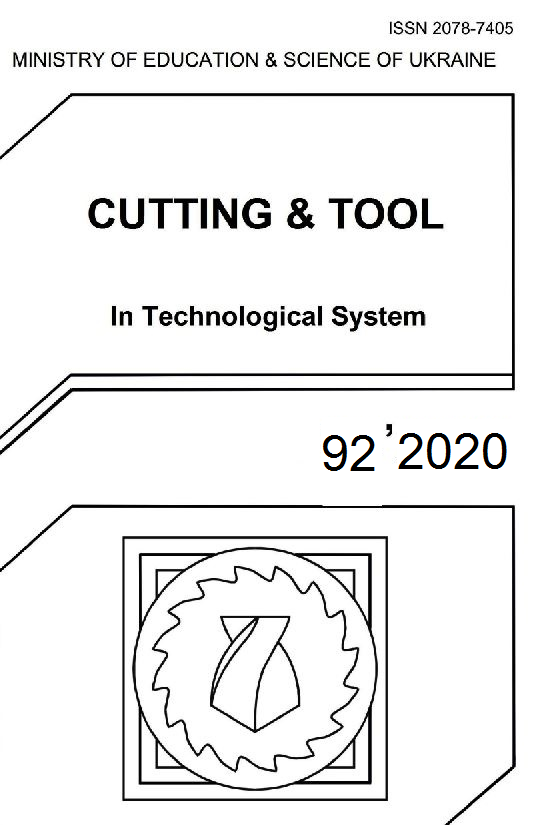ANALYSIS OF THE MACHINING SCHEME OF COMPLEX-PROFILES SHELLS OF ROTATION
DOI:
https://doi.org/10.20998/2078-7405.2020.92.13Keywords:
thin-walled shell, diamond grinding, the error of machining, mechanisms of parallel structures, process modeling.Abstract
Modern engineering products have complex geometry with high quality requirements, are made from new materials that is provoked the development and use the mechanisms of parallel structure, which are distinguished by high rigidity characteristics, as well as have wide functional capabilities. The precision problems of machining of complex-profile low-rigid parts, in particular thin-walled pyroceram shell are considered in article. Scheme of machining affect the accuracy and depends on the capabilities of technological equipment. Rationale for scheme of machining a thin-walled casing is presented in article. The accuracy of machining the outer profile of the casing was simulated for last step of diamond grinding. The simulation was performed for a traditional scheme of machining, which is performed for a lathe with an aggregate grinding head and a direct copying system, and for a scheme of machining for equipment that is fitted out with a mechanism with a parallel structure. The model of formation of the machining error is based on using the equations of relative displacement of the technological bases of the workpiece and the contact point of the working surface of the diamond wheel with the workpiece. The model takes into account the static and dynamic characteristics of the technological system and force factors during grinding. The calculations have confirmed that proposed solutions are able to provide the necessary machining precision. Changing the machining scheme of the workpiece and performing such machining on equipment with mechanisms of parallel structures eliminates the basing error, increases the rigidity of the technological system, and provides the possibility of turning the axis of the diamond wheel with the required angle.References
I. Pavlenko, D. Vakhnichenko, E. Kostyuk, V. Kropivniy. Tendenciyi rozvy`tku obladnannya z mexanizmamy` paralel`noyi struktury` [Trends in the development of equipment to the mechanisms of parallel structure]. Design, production and exploitation of agricultural machines, 2012, no.42 (2), pp. 181-186.
5-axis-machining centers. Available at: https://www.itmash.ru/katalog/5-ti-osevye-stanki-i-obrabatyvauschie-centry-s-chpu/pg2026-40-45-portal (accessed 18.03.2020).
Merlet, J.P. Parallel Robots [Solid Mechanics and Its Applications]. Berlin. Springer, 2006. 394 p.
Morgunov A.P., Chkhetiani E.Yu. Tehnologicheskoe obespechenie tochnosti mehanicheskoy obrabotki tonkostennyih detaley aviatsionnyih dvigateley [The technological base of machining precision of the thin-walled plane engine details]. Omsk Scientific Bulletin. Series «Equipment, Machines and Technologies», 2012, no.1 (107), pp. 130-132.
Lastovskiy P.N. Obespechenie zadannyih trebovaniy tochnosti pri avtomatizirovannoy tokarnoy obrabotke tonkostennyih detaley: avtoref. dy`s. na zdobuttya nauk. stupenya kand. texn. nauk: specz. 05.02.08 “Texnologiya mashy`nobuduvannya” [Ensuring specified accuracy requirements for automated turning of thin-walled parts. Abstract of a thesis candidate eng. sci. diss (Ph. D) 050208 “Technology of mechanical engineering”]. Omsk, 2010.
p.
Kolluru Kiran, Axinte Dragos, Becker Adib. A solution for minimising vibrations in milling of thin walled casings by applying dampers to workpiece surface. CIRP Annals - Manufacturing Technology, 2013, no.62, pp.415-418.
Pokolenko D. V. Pidvy`shhennya efekty`vnosti obrobky` antenny`x obtichny`kiv iz sy`taliv za raxunok udoskonalennya texnologiyi almaznogo shlifuvannya: avtoref. dy`s. na zdobuttya nauk. stupenya kand. texn. nauk: specz. 05.02.08 “Texnologiya mashy`nobuduvannya” [Improvement of the efficiency of machining antenna cords from cetalls by improving the technology of diamond grinding. Abstract of a thesis candidate eng. sci. diss (Ph. D) 050208 “Technology of mechanical engineering”]. Donetsk, 2014. 20 p.
Kalafatova L. P. Texnologichni osnovy` pidvy`shhennya efekty`vnosti obrobky` ta zabezpechennya yakosti vy`robiv iz texnichny`x stekol i sy`taliv: avtoref. dy`s. na zdobuttya nauk. stupenya doct. texn. nauk: specz. 05.02.08 “Texnologiya mashy`nobuduvannya” [Technological Basis of the Defectness of Raise of Efficiency of Machining and Provision of the Required Quality of the Articles Made of Technical Glass and Cetalls. Abstract of a thesis Dokt. Of Techn. Sciences diss 050208 “Technology of mechanical engineering”]. Kharkiv, 2001. 24 p.
Kalafatova L. P., Matjuha P. G., Pokolenko V. D., Olejnik S. Ju., Poezd S. A. Povyshenie jeffektivnosti shlifovanija tverdyh splavov i konstrukcionnoj keramiki: monografija [Improving the efficiency of grinding of hard alloys and structural ceramics. Pokrovsk, CEI DonNTU Publ., 2017. 182 p.
Vyal`cev M.V., Gusyev V.V., Molchanov O.D., Pokolenko D.V., Sirchenko O.V. Sposib shlifuvannya til obertannya z pryamolinijny`my` i kry`volijny`my` tvirny`my` [Method of grinding the rotational bodies with straight and curvilinear generator]. Patent UA, no.54942, 2005.
Kalafatova L.P., Oleynyk S.Yu., Pokolenko D.V. Matematicheskaya model dlya opredeleniya zakonomernostey formirovaniya pogreshnosti obrabotki pri shlifovanii obolochek slozhnogo profilya iz sitalla. [The mathematical model to determine the regularities of the formation of the machining errors during grinding the glass-ceramic shells of complex profile]. Technologes of informations are in education, science and production, 2016, no.2(13), pp.89-99.
Kalafatova L.P., Oleynyk S.Yu., Pokolenko D.V. Povyishenie tochnosti obrabotki pri vnutrennem shlifovanii tonkostennyih obolochek slozhnoy formyi iz hrupkih nemetallicheskih materialov [Improving the accuracy of machining during internal grinding of thin-walled shells of complex shape from brittle non-metallic materials]. Cutting & tool in technological system, 2017, no.87, pp. 85-96.
Downloads
Published
Issue
Section
License
Copyright Notice
Authors who publish with this Collection agree to the following terms:
1. Authors retain copyright and grant the Collection right of first publication with the work simultaneously licensed under a Creative Commons Attribution License that allows others to share the work with an acknowledgement of the work's authorship and initial publication in this Collection.
2. Authors are able to enter into separate, additional contractual arrangements for the non-exclusive distribution of the Collection's published version of the work (e.g., post it to an institutional repository or publish it in a book), with an acknowledgement of its initial publication in this Collection.
3. Authors are permitted and encouraged to post their work online (e.g., in institutional repositories or on their website) prior to and during the submission process, as it can lead to productive exchanges, as well as earlier and greater citation of published work.

